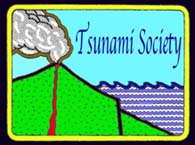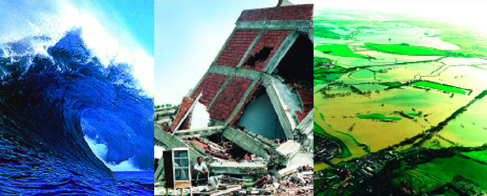ISSUES - Year 2010
ISSN 8755-6839
Complete Journal - STHVol29N2Y2010
(PDF Document 17 MB)
Compressed Journal - STHVol29N2Y2010 (PDF Document 5.2 MB)
(Please allow time for loading papers and journal in full and in compressed formats. Illustrations in compressed formats are of lesser quality)
--------------------------------------------
ABSTRACTS
for Volume 29, No 2
FLOW AND POTENTIAL FORCE DUE TO RUNUP TSUNAMI AROUND A COASTAL
FOREST WITH A GAP – EXPERIMENTS AND NUMERICAL SIMULATIONS
Nguyen Ba Thuy - Graduate School, Science & Engineering, Saitama University, Saitama, JAPAN
Katsutoshi Tanimoto - Emeritus Professor, Saitama University, JAPAN.
Norio Tanaka - Professor, Institute for Environmental Science and Technology, Saitama University, Saitama, JAPAN.
ABSTRACT
In the present study, laboratory experiments were conducted to validate the applicability of numerical model based on two-dimensional nonlinear long-wave equations including drag resistance of trees and turbulence induced shear forces to tsunami flow around a simplified forest with a gap in a wave channel. It was confirmed that the water surface elevation and flow velocity by the numerical simulations agree well with the experimental results for various forest conditions of width and tree density. Then the numerical model was applied to a prototype scale condition of a coastal forest of Pandanus odoratissimus with a gap to investigate the effects of forest conditions (width and tree density) and incident tsunami conditions (period and height) on a potential tsunami force. The potential tsunami force at the gap exit is greatly enhanced and the maximum in the spatial distribution around and inside the forest. The potential tsunami forces at four representative points at front and back of forest including the center of gap exit were analyzed for various conditions and formulated as function of forest and tsunami conditions in the non-dimensional form. The potential tsunami forces calculated by the curve-fit formula agree well with the simulated potential tsunami forces within ±10% error.
Key words: Runup tsunami, Coastal forest, Gap, Pandanus odoratissimus, Tsunami force
FLOW AND POTENTIAL FORCE DUE TO RUNUP TSUNAMI AROUND A COASTAL
FOREST WITH A GAP – EXPERIMENTS AND NUMERICAL SIMULATIONS (5.7MB)
FLOW AND POTENTIAL FORCE DUE TO RUNUP TSUNAMI AROUND A COASTAL
FOREST WITH A GAP – EXPERIMENTS AND NUMERICAL SIMULATIONS COMPRESSED 3.6.MB)
Science of Tsunami Hazards, Vol. 29, No. 2, page 43 (2010)
--------------------------------------------
TSUNAMI HAZARD AND TOTAL RISK IN THE CARIBBEAN BASIN
X. William Proenza - National Oceanic and Atmospheric Administration
National Weather Service,
Fort Worth, Texas, USA
George A. Maul - Florida Institute of Technology
Department of Marine and Environmental Systems
Melbourne, Florida, USA
ABSTRACT
Deadly western North Atlantic Ocean tsunami events in the last centuries have occurred along the east coast of Canada, the United States, most Caribbean islands, and the North Atlantic Coast of South America. The catastrophic Indian Ocean tsunami of 2004 reminded natural hazards managers that tsunami risk is endemic to all oceans. Total Risk is defined as hazard (frequency of tsunami events) times measures of elements at risk (human exposure) times measures of vulnerability (preparedness) in a given epoch (Nott, 2006). While the tsunami hazard in the Caribbean (averaging 19 ± 22 years between deadly events) is lower than Pacific coastal areas, the total risk to life and property is at least as high as the USA West Coast, Hawaii, or Alaska, because of the higher Caribbean population density and beach tourism so attractive to more than 35 million visitors a year. Viewed in this light, the allocation of resources by governments, industry, and insurers needs to be adjusted for the better protection of life, for coastal engineering, and for infrastructure.
Key words: Caribbean, tsunami risk, hazard risk, tsunami reccurrence, disaster mitigation, preparedness, protection of life, tsunami warning system.
TSUNAMI HAZARD AND TOTAL RISK IN THE CARIBBEAN BASIN
Science of Tsunami Hazards, Vol. 29, No. 2, page 70 (2010)
--------------------------------------------
OPTIMAL LOCATION OF TSUNAMI WARNING BUOYS AND SEA LEVEL
MONITORING STATIONS IN THE MEDITERRANEAN SEA
Layna Groen - Dept. of Mathematical Sciences,
University of Technology,
Sydney, NSW AUSTRALIA
Anthony Joseph - Dept. of Mathematical Sciences,
University of Technology,
Sydney, NSW AUSTRALIA
Eileen Black - Dept. of Mathematical Sciences,
University of Technology,
Sydney, NSW AUSTRALIA
Marianne Menictas - Dept. of Mathematical Sciences,
University of Technology,
Sydney, NSW AUSTRALIA
Winson Tam - Dept. of Mathematical Sciences,
University of Technology,
Sydney, NSW AUSTRALIA
Mathew Gabor - Dept. of Mathematical Sciences,
University of Technology,
Sydney, NSW
AUSTRALIA
ABSTRACT
The present study determines the optimal location of detection components of a tsunami warning system in the Mediterranean region given the existing and planned infrastructure. Specifically, we examine the locations of existing tsunameters DART buoys and coastal sea-level monitoring stations to see if additional buoys and stations will improve the proportion of the coastal population that may receive a warning ensuring a timely response. A spreadsheet model is used to examine this issue. Based on the historical record of tsunamis and assuming international cooperation in tsunami detection, it is demonstrated that the existing network of sea level stations and tsunameters enable around ninety percent of the coastal population of the Mediterranean Sea to receive a 15 minute warning. Improvement in this result can be achieved through investment in additional real-time, coastal, sea level monitoring stations. This work was undertaken as a final year undergraduate research project.
Key words: tsunami warning system, spreadsheet modelling, optimal location.
OPTIMAL LOCATION OF TSUNAMI WARNING BUOYS AND SEA LEVEL
MONITORING STATIONS IN THE MEDITERRANEAN SEA
Science of Tsunami Hazards, Vol. 29, No. 2, page 78 (2010)
--------------------------------------------
THE EARTHQUAKE AND TSUNAMI OF 27 FEBRUARY 2010 IN CHILE – Evaluation of Source Mechanism and of Near and Far-field Tsunami Effects
George Pararas-Carayannis -
Tsunami Society International, Honolulu, Hawaii, USA
ABSTRACT
The great earthquake of February 27, 2010 occurred as thrust-faulting along a highly stressed coastal segment of Chile's central seismic zone - extending from about 33ºS to 37ºS latitude - where active, oblique subduction of the Nazca tectonic plate below South America occurs at the high rate of up to 80 mm per year. It was the 5th most powerful earthquake in recorded history and the largest in the region since the extremely destructive May 22, 1960 magnitude 9.5 earthquake near Valdivia. The central segment, south of Valparaiso from about 34º South to 36º South had been identified as a moderate seismic gap where no major or great, shallow earthquakes had occurred in the last 120 years, with the exception of a deeper focus, inland event in 1939. The tsunami that was generated by the 2010 earthquake was highest at Robinson Crusoe Island in the Juan Fernández Archipelago as well as in Talchuano, Dichato, Pelluhue and elsewhere on the Chilean mainland, causing numerous deaths and destruction. Given the 2010 earthquake’s great moment magnitude of 8.8, shallow focal depth and coastal location, it would have been expected that the resulting tsunami would have had much greater Pacific-wide, far field effects similar to those of 1960, which originated from the same active seismotectonic zone. However, comparison of the characteristics of the two events indicates substantial differences in source mechanisms, energy release, ruptures, spatial clustering and distributions of aftershocks, as well as in geometry of subduction and extent of crustal displacements on land and in the ocean. Also, the San Bautista and the Juan Fernández Islands - ridges rising from the ocean floor – as well as the O’Higgins seamount/guyot may have trapped some of the tsunami energy, thus accounting for the smaller, far field tsunami effects observed elsewhere in the Pacific. Apparently, complex, localized structural anomalies and interactions of the Nazca tectonic plate with that of South America, can account for differences in the spatial distribution and clustering of shallow event hypocenters, as well as for seismic gaps where large tsunamigenic earthquakes could strike Chile’s Central Seismic zone in the future.
Key Words: Tsunami, Chile, seismotectonics, Peru-Chile subduction, energy trapping.
THE EARTHQUAKE AND TSUNAMI OF 27 FEBRUARY 2010 IN CHILE – Evaluation of Source Mechanism and of Near and Far-field Tsunami Effects (10.3 MB)
THE EARTHQUAKE AND TSUNAMI OF 27 FEBRUARY 2010 IN CHILE – Evaluation of Source Mechanism and of Near and Far-field Tsunami Effects (COMRESSED 852 KB)
Science of Tsunami Hazards, Vol. 29, No. 2, page 96 (2010)
--------------------------------------------
Copyright © 2010 - TSUNAMI SOCIETY INTERNATIONAL
TSUNAMI SOCIETY INTERNATIONAL, 1741 Ala Moana Blvd. #70, Honolulu, HI 96815, USA.
WWW.TSUNAMISOCIETY.ORG




